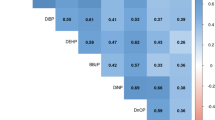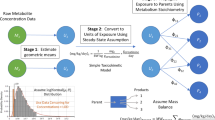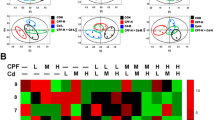Abstract
The Third National Health and Nutrition Examination Survey (NHANES-III) of the Centers for Disease Control and Prevention (CDC) recorded data on the urinary concentrations of 12 chemicals (analytes), which were either pesticides or their metabolites, that represent exposure to certain pesticides, in urine samples collected from 1988 to 1994 from a cohort of 978 volunteer subjects, aged 20–59 years. We have used each subject's urinary creatinine concentration and their individual daily creatinine excretion rate (g/day) computed from their age, gender, height and weight, to estimate their daily excretion rate in μg analyte/kg/day. We discuss the mechanisms of excretion of the analytes and certain assumptions needed to compute the equivalent daily dietary intake (μg/kg/day) of the most likely parent pesticide compounds for each excreted analyte. We used literature data on the average amount of parent compound ingested per unit amount of the analyte excreted in the urine, and compared these estimated daily intakes to the US EPA's reference dose (RfD) values for each of those parent pesticides. A Johnson SB distribution (four-parameter lognormal) was fit to these data to estimate the national distribution of exclusive exposures to these 12 parent compounds. Only three such pesticides had a few predicted values above their RfD (lindane 1.6%; 2,4-dichlorophenol 1.3%; chlorpyrifos 0.02%). Given the possibility of a subject's dietary intake of a pesticide's metabolites incorporated into treated food, our results show that few, if any, individuals in the general US population aged 20–59 years and not employed in pesticide application were likely to have exceeded the USEPA RfD for these parent compounds during the years studied.
This is a preview of subscription content, access via your institution
Access options
Subscribe to this journal
Receive 6 print issues and online access
$259.00 per year
only $43.17 per issue
Buy this article
- Purchase on Springer Link
- Instant access to full article PDF
Prices may be subject to local taxes which are calculated during checkout
Similar content being viewed by others
Notes
where 1.93=(1440 min/day)(1000 μg/mg)/(72 year-kg/[mg/dl-ml/min-1.73 m2])(3600 cm-kg/m4)0.5 (1.73 m2)(100 ml/dl)
Abbreviations
- 1NAP:
-
1-naphthol
- 2NAP:
-
2-naphthol
- 24D:
-
2,4-dichlorophenoxyacetic acid
- 24DB:
-
2,4-dichlorophenoxybutyric acid
- 24DCP:
-
2,4-dichlorophenol
- 245TCP:
-
2,4,5-trichlorophenol
- 246TCP:
-
2,4,6-trichlorophenol
- 25DCP:
-
2,5-dichlorophenol
- 4NP:
-
4-nitrophenol
- BSA:
-
body surface area
- CDC:
-
Centers for disease control and prevention
- CFP:
-
carbofuranphenol
- Cn:
-
creatinine
- CnCl:
-
creatinine clearance
- EPN:
-
O-ethyl O-p-nitrophenyl phenylphosphonothioate
- IPP:
-
2-isopropoxyphenol
- MDL:
-
minimum detectable level
- MLE:
-
method of maximum likelihood estimation
- NCEH:
-
National Center for Environmental Health
- NCHS:
-
National Center for Health Statistics
- NHANES-III:
-
The Third National Health and Nutrition Examination Survey
- PCP:
-
pentachlorophenol
- RfD:
-
reference dose
- TCPY:
-
3,5,6-trichloro-2-pyridinol
- Tm:
-
transport maximum
- USDHHS:
-
US Department of Health and Human Services
- US EPA:
-
US Environmental Protection Agency
References
Adgate J.L., Barr D.B., Clayton C.A., Eberly L.E., Freeman N.C., Lioy P.J., Needham L.L., Pellissari E.D., Quackenboss J.J., Roy A., and Sexton K. Measurement of children's exposure to pesticides: analysis of urinary metabolite levels in a probability-based sample. Environ Health Perspect 2001: 109: 583–590.
Alessio L., Berlin A., Dell'Orto A., Toffoletto F., and Ghezzi I. Reliability of urinary creatinine as a parameter to adjust values of urinary biological indicators. Int Arch Occup Environ Health 1985: 55: 99–106.
Araki S. Effects of urinary volume on urinary concentration of lead, aminolaevulinic acid, coproporphyrin, creatinine, and total solutes. Br J Ind Med 1980: 62: 471–477.
Bennett S., and Wilkins H.A. Within-person variation in urinary sodium, potassium and creatinine concentrations, and their relationship to changes in the blood pressure. J Trop Med Hyg 1993: 96: 267–273.
Berkhin E.B., and Humphreys M.H. Regulation of renal tubular secretion of organic compounds. Kidney Int 2001: 59: 17–30.
Bingham S.A., and Cummings J.H. The use of creatinine output as a check on the completeness of 24-hour urine collections. Hum Nutr Clin Nutr 1985: 39: 343–353.
Buck R.J., Özkaynak H., Xue J., Zartarian V.G., and Hammerstrom K. Modeled estimates of chlorpyrifos exposure and dose for the Minnesota and Arizona NHEXAS populations. J Expos Anal Environ Epidemiol 2001: 11: 253–268.
Cho M.M., and Yi M.M. Variability of daily creatinine excretion in healthy adults. Hum Nutr Clin Nutr 1986: 40: 469–472.
Cockcroft D.W., and Gault M.H. Prediction of creatinine clearance from serum creatinine. Nephron 1976: 16: 31–41.
Dell'Orto A., Berlin A., Toffoletto F., Losito B., and Alessio L. Creatinine and specific gravity adjustment of ALA in urinary spot samples: is there any need? Am Ind Hyg Assoc J 1987: 48: A331–A332.
Greenblatt D.J., Ransil B.J., Harmatz J.S., Smith T.W., Duhme D.W., and Koch-Weser J. Variability of 24-hour urinary creatinine excretion by normal subjects. J Clin Pharmacol 1976: 16: 321–328.
Hill Jr R.H., Shealy D.B., Head S.L., Williams C.C., Bailey S.L., Gregg M., and Needham. L.L. Pesticide residues in urine of adults living in the United States: reference range concentrations. Environ Res 1995: 71: 99–108.
Johnson N.L. Systems of frequency curves generated by methods of translation. Biometrika 1949: 36: 149–172.
Mage D.T. An explicit solution for SB parameters using four percentile points. Technometrics 1980: 22: 247–251.
Mosteller R.D. Simplified calculation of body surface area. New Engl J Med 1987: 317: 1098 (letter).
Neithardt A.B., Dooley S.L., and Borensztajn J. Prediction of 24-hour protein excretion in pregnancy with a single voided urine protein-to-creatinine ratio. Am J Obst Gyn 2002: 186: 883–886.
Nolan R.J., Rick D.L., Freshour N.L., and Saunders J.H. Chlorpyrifos: pharmacokinetics in human volunteers. Toxicol Appl Pharm. 1984: 73: 8–15.
Radha E., and Bessman S.P. Effect of exercise on protein degradation: 3-methylhistidine and creatinine excretion. Biochem Med 1983: 29: 96–100.
Sata F., Araki S., Yokoyama K., and Murata K. Adjustment of creatinine-adjusted values in urine to urinary flow rate: a study of eleven heavy metals and organic substances. Int Arch Occup Environ Health 1995: 68: 64–68.
Schwartz G.J., Brion L.P., and Spitzer A. The use of plasma creatinine concentration for estimating glomerular filtration rate in infants, children and adolescents. Pediatr Clin North Am 1987: 34: 571–590.
Shull B.C., Haughey D., Koup J.R., Baliah T., and Li P.K. A useful method for predicting creatinine clearance in children. Clin Chem 1978: 24: 1167–1169.
Trevisan A. Concentration adjustment of spot samples in analysis of urinary xenobiotic metabolites. Am J Ind Med 1990: 17: 637–642.
US Department of Health and Human Services (DHHS). National Center for Health Statistics. Third National Health and Nutrition Examination Survey, 1988–1994, NHANES III Priority Toxicant Reference Range Study Data File (3.5 Diskette, Series 11, No. 4A), Centers for Disease Control and Prevention, Hyattsville, MD, 1999.
USEPA. Ambient Water Quality Criteria Document: Chlorinated Phenols p. A-7 EPA 440/5-80-032, Washington, DC, 1980.
Vij H.S., and Howell S. Improving the specific gravity adjustment method for assessing urinary concentrations of toxic substances. Am Ind Hyg Assoc J 1998: 59: 375–380.
Waterlow J.C. Observations on the variability of creatinine excretion. Hum Nutr Clin Nutr 1986: 40: 125–129.
Wilson N.K., Chuang J.C., Lyu C., Menton R., and Morgan M.K. Aggregate exposures of nine preschool children to persistent organic pollutants at day care and at home. J Expos Anal Environ Epidemiol 2003: 13: 187–202.
Acknowledgements
This work was supported under USEPA Contract 401893671 - DAI to Temple University. Jennifer Weil, MD, of Temple University and David J. Miller, Carol Christensen and Peter Egeghy of US EPA provided technical review. The views expressed are those of the authors, and they do not represent US EPA policy.
Author information
Authors and Affiliations
Corresponding author
Rights and permissions
About this article
Cite this article
Mage, D., Allen, R., Gondy, G. et al. Estimating pesticide dose from urinary pesticide concentration data by creatinine correction in the Third National Health and Nutrition Examination Survey (NHANES-III). J Expo Sci Environ Epidemiol 14, 457–465 (2004). https://doi.org/10.1038/sj.jea.7500343
Published:
Issue Date:
DOI: https://doi.org/10.1038/sj.jea.7500343
Keywords
This article is cited by
-
A systematic review: on the mercaptoacid metabolites of acrylamide, N-acetyl-S-(2-carbamoylethyl)-L-cysteine
Environmental Science and Pollution Research (2023)
-
Bayesian inference of chemical exposures from NHANES urine biomonitoring data
Journal of Exposure Science & Environmental Epidemiology (2022)
-
Exposure forecasting – ExpoCast – for data-poor chemicals in commerce and the environment
Journal of Exposure Science & Environmental Epidemiology (2022)
-
Is the World Health Organization predicted exposure assessment model for space spraying of insecticides applicable to agricultural farmers?
Environmental Science and Pollution Research (2019)
-
Estimated Daily Intake and Cumulative Risk Assessment of Phthalates in the General Taiwanese after the 2011 DEHP Food Scandal
Scientific Reports (2017)



